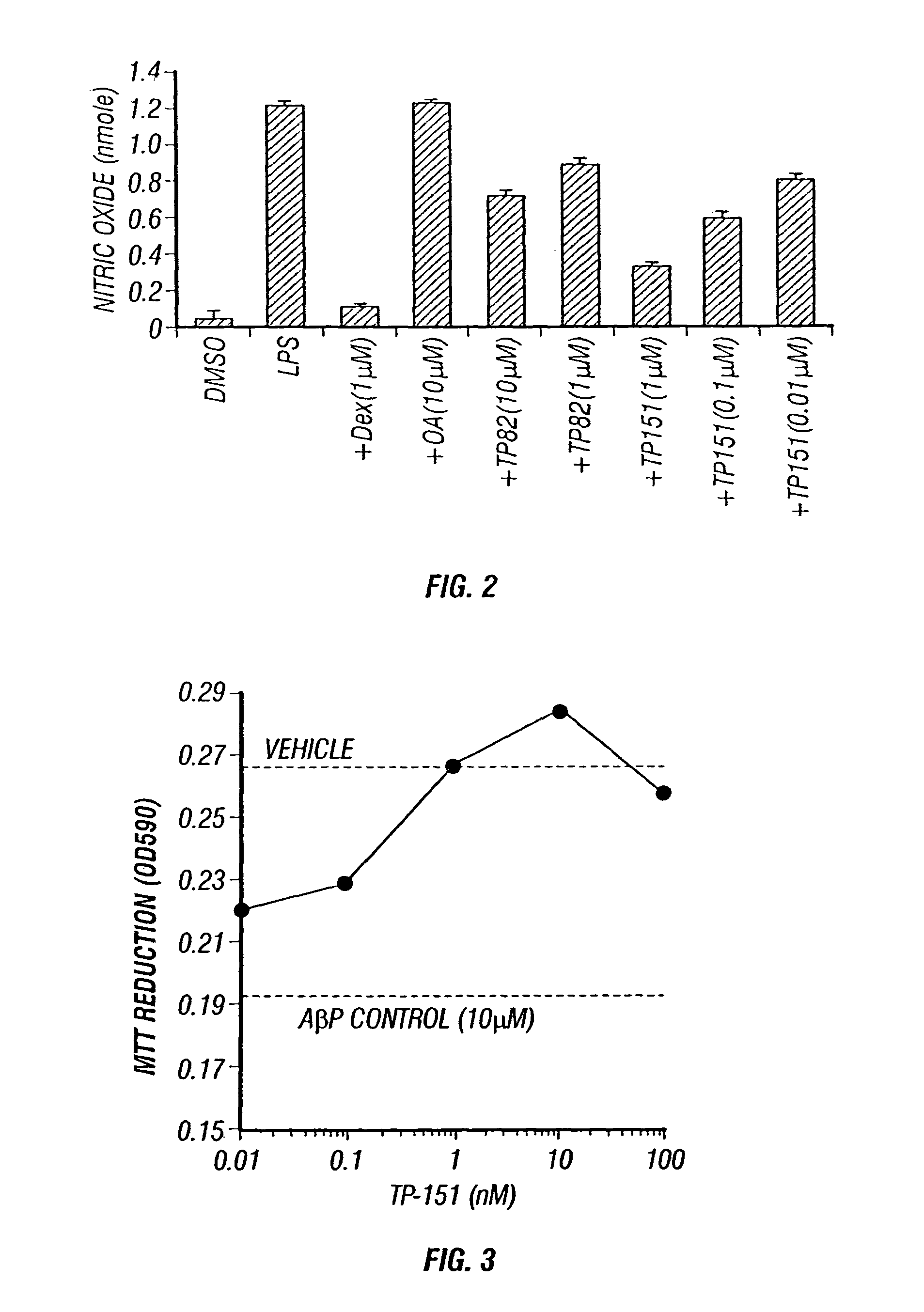Therapeutic compositions and methods of use
a technology of compositions and therapeutic compounds, applied in the field of compounds, can solve the problems of relatively weak biological activity of naturally occurring molecules, and achieve the effect of preventing or treating
- Summary
- Abstract
- Description
- Claims
- Application Information
AI Technical Summary
Benefits of technology
Problems solved by technology
Method used
Image
Examples
example 1
[0079]Compounds were synthesized as below:
[0080][0081]a: HCO2Et / MeONa / THF,b: PhSeCl / AcOEt; 30% H2O2 / THF,c: NH2OH—HCl / EtOH / H2O, d: MeONa / MeOH / Et2O,e: KOH / MeOH,f: Jones,g:HCO2Et / MeONa / PhH,h: Lil / DMF
[0082]Compound 10 was prepared by formylation of OA (Compound 9) (Simonsen and Ross, 1957) with ethyl formate in the presence of sodium methoxide in THF (Clinton et al., 1961). Compound 7 was obtained by introduction of a double bond at C-1 of Compound 10 with phenylselenenyl chloride in ethyl acetate and sequential addition of 30% hydrogen peroxide (Sharpless et al., 1973). Compound 11 was synthesized from Compound 10 by addition of hydroxylamine in aqueous ethanol; cleavage of Compound 11 with sodium methoxide gave Compound 12 (Johnson and Shelberg, 1945). Compound 14 was prepared from Compound 13 (Picard et al., 1939) by alkali hydrolysis followed by Jones oxidation. Compound 15 was prepared by formylation of Compound 14 with ethyl formate in the presence of sodium methoxide in benzene. ...
example 2
Induction of Differentiation in Myelogenous Leukemia Cells, PC12 Pheochromocytoma Cells, and 3T3-L1 Fibroblasts
[0087]CDDO induces monocytic differentiation in the poorly differentiated LCDB acute myelogenous leukemia cell line, derived from a chemotherapy-resistant patient at the NCI Pediatric Oncology Branch. FIG. 11 illustrates LCDB cells seeded in RPMI 1640 / 2% FBS, either alone (11A), with 2.5 ng / ml TGF-β1 (11B), with 10−8 M CDDO (11C), or with both TGF-β1 and CDDO (11D). After 48 h, cytospin slide preparations were made and stained for α-naphthyl acetate esterase activity (kit from Sigma). PC 12 cells were cultured for 5 days in gridded dishes in DMEM / 10% FBS and 5% horse serum (Smith et al., 1997), either alone (11E), with 100 ng / ml 7S NGF (11F), with 10 −6 M CDDO (11G), or with both NGF and CDDO (11H). Cells were plated in triplicate, and for each treatment similar results were observed in at least two separate platings of cells. Methods for quantitative image analysis of size...
example 3
CDDO Inhibits Proliferation of Many Malignant or Premalignant Cells
[0090]Inhibitors of cell proliferation are known to be useful chemopreventive and chemotherapeutic agents. CDDO was tested against a wide variety of cells derived from highly aggressive leukemias and carcinomas, as well as from non-neoplastic tissues. NRP-152 cells were grown as described in Danielpour et al., 1994. MCF-7 cells were grown in phenol red-free RPMI 1640 / 10% charcoal-stripped FBS with added 17-β-estradiol (10 μM). Triterpenoids were added at the time of plating, and 72 h later 3H-thymidine (1 μCi / well) was added for the final 2 h of incubation. Incorporation of thymidine was measured after cells were precipitated with TCA (10%), washed, and solubilized. The symbols used in FIG. 13 are CDDO, ▪; TP-82, ◯; and oleanolic acid; ●.
[0091]Typical dose-response curves are shown in FIG. 13 for two cell types, human MCF-7 breast carcinoma and rat NRP-152 non-malignant prostate epithelium (Danielpour et al., 1994). ...
PUM
| Property | Measurement | Unit |
|---|---|---|
| diameter | aaaaa | aaaaa |
| length | aaaaa | aaaaa |
| time | aaaaa | aaaaa |
Abstract
Description
Claims
Application Information
 Login to View More
Login to View More - R&D
- Intellectual Property
- Life Sciences
- Materials
- Tech Scout
- Unparalleled Data Quality
- Higher Quality Content
- 60% Fewer Hallucinations
Browse by: Latest US Patents, China's latest patents, Technical Efficacy Thesaurus, Application Domain, Technology Topic, Popular Technical Reports.
© 2025 PatSnap. All rights reserved.Legal|Privacy policy|Modern Slavery Act Transparency Statement|Sitemap|About US| Contact US: help@patsnap.com



